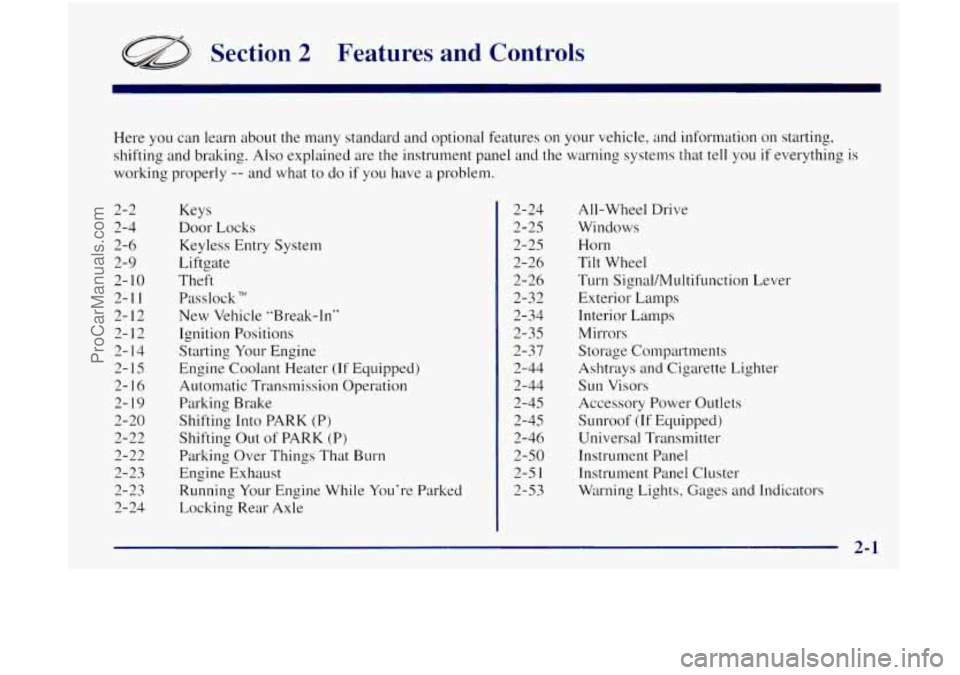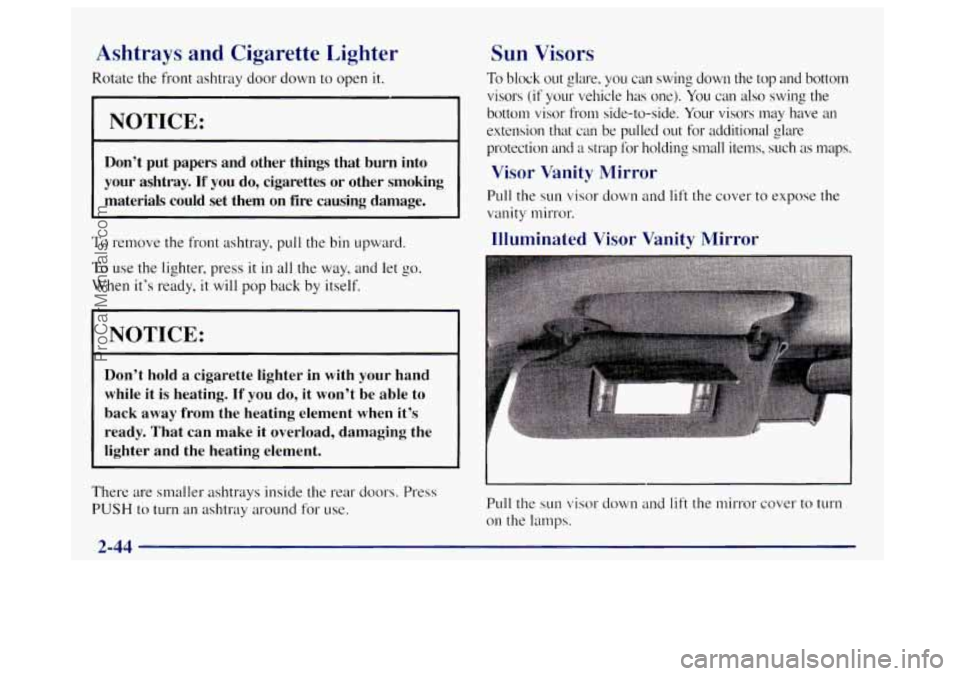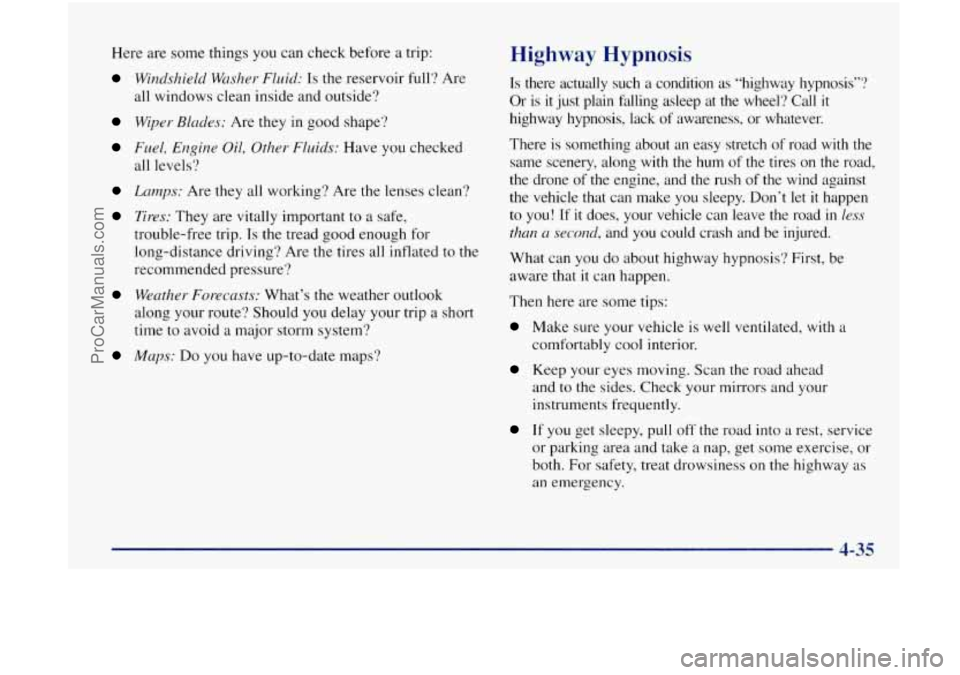mirror OLDSMOBILE BRAVADA 1998 Owners Manual
[x] Cancel search | Manufacturer: OLDSMOBILE, Model Year: 1998, Model line: BRAVADA, Model: OLDSMOBILE BRAVADA 1998Pages: 380, PDF Size: 19.2 MB
Page 65 of 380

a Section 2 Features and Controls
Here you can learn about the many standard and optional features on your vehicle, and information on starting,
shifting and braking. Also explained are
the instrument panel and the warning systems that tell you if everything is
working properly
-- and what to do if you have a problem.
2-2
2-4
2-6
2-9
2-
10
2-1 1
2- 12 2- 12
2- 14
2- 15
2-16
2- 19
2-20
2-22
2-22
2-23
2-23
2- 24 Keys
Door Locks
Keyless Entry System
Liftgate
Theft Passlock
TM
New Vehicle “Break-In”
Ignition Positions
Starting Your Engine
Engine Coolant Heater
(If Equipped)
Automatic Transmission Operation
Parking Brake
Shifting Into PARK
(P)
Shifting Out of PARK (P)
Parking Over Things That Burn
Engine Exhaust
Running Your Engine While You’re Parked
Locking Rear Axle 2-24
2-25
2-25
2-26
2-26
2-32 2-34
2-35
2-37 2-44
2-44
2-45
2-45 2-46
2-50
2-5
1
2-53 All-Wheel Drive
Windows Horn
Tilt Wheel
Turn Signal/Multifunction Lever
Exterior Lamps
Interior Lamps
Mirrors
Storage Compartments Ashtrays and Cigarette Lighter
Sun Visors
Accessory Power Outlets
Sunroof (If Equipped)
Universal Transmitter Instrument Panel
Instrument Panel Cluster
Warning Lights, Gages and Indicators
ProCarManuals.com
Page 99 of 380

Battery Run-Down Protection
This feature shuts off the dome, courtesy. vanity.
reading, glove
box and underhood lamps if they are left
on for more than
20 minutes when the ignition is off.
This
will keep your battery from running do~n.
Mirrors
Electrochromic Day/Night Rearview Mirror
This mirror auton~atically changes to reduce glare from
headlamps behind you.
A photocell on the back of the
mirror senses when
it is becoming dark outside. Another
photocell
built into the mirror surface senses when
headlamps are behind
you.
At night, when the glare is too high, the mirror will
gradually darken to reduce glare (this change may take a
few seconds). The mirror will return to its clear daytime
state when
the glare is reduced.
Press the button
at the base of the mirror to turn on the
automatic feature. The button has
an indicator light to
show
it is on. Press the button again to turn the
automatic feature
off.
Time Delay
The automatic mirror has a time delay feature which
prevents unnecessary switching from the night back to
the day position. This delay prevents rapid changing of
the mirror
as you drive under lights and through traffic.
Cleaning the Photocells
Use a cotton swab and glass cleaner to clean the
photocells
when necessary.
Outside Manual Adjust Mirror
Adjust your outside min-ors so you can just see the side
of your vehicle.
You can fold them before entering
a car wash. Pull the
mirrors in toward the vehicle. Push the mirrors back out
when finished.
2-35
ProCarManuals.com
Page 100 of 380

Power Remote Control Mirror
Move the control to the left or right to choose the
mirror, then press the arrows on the control pad to
adjust the mirror.
Convex Outside Mirror
Your passenger’s side mirror is convex. A convex
mirror’s surface
is curved so you can see more from the
driver’s seat.
AUTION:
A convex mirror can make things (like other
vehicles) look farther away than they really are.
If you cut
too sharply into the right lane, you
could hit
a vehicle on your right. Check your
inside mirror or glance over your shoulder before
changing lanes.
2-36
ProCarManuals.com
Page 108 of 380

Ashtrays and Cigarette Lighter
Rotate the front ashtray door down to open it.
NOTICE:
Don’t put papers and other things that burn into
your ashtray.
If you do, cigarettes or other smoking
materials could set them on
fire causing damage.
To remove the front ashtray, pull the bin upward.
IO use the lighte’f, f~’esS it in all the way, and let go.
When it’s ready,
it will pop back by itself.
NOTICE:
Don’t hold a cigarette lighter in with your hand
while it is heating.
If you do, it won’t be able to
back away from the heating element when it’s
ready. That can make it overload, damaging the
lighter and the heating element.
There are smaller ashtrays inside the rear doors. Press
PUSH to turn an ashtray around for use.
Sun Visors
To block out glare, you can swing down the top and bottom
visors (if your vehicle has one). You
can also swing the
bottom visor from side-to-side. Your visors may have an
extension that can be pulled out for additional glare protection and
a strap for holding small items, such as maps.
Visor Vanity Mirror
Pull the sun visor clown and lift the cover to expose the
vanity mirror.
Illuminated Visor Vanity Mirror
W
Pull the sun visor down and lift the mirror cover to turn
on the lamps.
2-44
ProCarManuals.com
Page 165 of 380

0 When it looks like a chance to pass is coming up,
start to accelerate but stay in
the right lane and don’t
get too close. Time your move
so you will be
increasing speed as the time comes to move into the
other lane.
If the way is clear to pass, you will have a
“running start” that more than makes up for the
distance you would lose by dropping back. And
if
something happens to cause you to cancel your pass,
you need only slow down and drop back again and
wait for another opportunity.
If other cars are lined up to pass a slow vehicle, wait
your turn. But take care that someone isn’t trying to
pass you as you pull out to pass the slow vehicle.
Remember to glance over your shoulder and check
the blind spot.
0 Check your mirrors, glance over your shoulder and
start your left lane change signal before moving out
of the right lane to pass. When you are far enough
ahead of
the passed vehicle to see its front in your
inside mirror, activate your right lane change signal
and move back into the right lane. (Remember that
your right outside mirror is convex. The vehicle you
just passed may seem to be farther away from you
than
it really is.)
0 Try not to pass more than one vehicle at a time on
two-lane roads, Reconsider before passing the
next vehicle.
0 Don’t overtake a slowly moving vehicle too rapidly.
Even though the brake lamps are not flashing,
it may
be slowing down or starting to turn.
0 If you’re being passed, make it easy for the
following driver to get ahead
of you. Perhaps you
can ease
a little to the right.
4- 1
ProCarManuals.com
Page 166 of 380

Loss of Control
Let's review what driving experts say about what
happens when the three control systems (brakes, steering
and acceleration) don't have enough friction where the
tires meet the road to do what the driver has asked.
In any emergency, don't give up. Keep trying to steer and
constantly seek an escape route or area of less danger.
Skidding
In a skid, a driver can lose control of the vehicle.
Defensive drivers avoid most skids by taking reasonable
care suited
to existing conditions, and by not "overdriving"
those conditions.
But skids are always possible.
The three types
of skids correspond to your vehicle's
three control systems.
111 the braking skid, your wheels
aren't rolling.
In the steering or cornering skid, too
much speed or steering
in a curve causes tires to slip and
lose cornering force. And
in the acceleration skid, too
much throttle causes the driving wheels to spin.
A cornering skid and an acceleration skid are best
handled by easing your foot off the accelerator pedal.
If your vehicle starts to slide, ease your foot off the
accelerator pedal and quickly steer the way you want the
vehicle to
go. If you start steering quickly enough, your
vehicle may straighten out. Always be ready for
a
second skid if it occurs.
Of' course, traction is reduced when water, snow, ice,
c gravel or other material is on the road. For safety, you'll
want to slow down
and ad-just your driving to these
conditions.
It is important to slow down on slippery
surfaces because stopping distance
will be longer and
vehicle control more limited.
While driving on
a surface with reduced traction, try
your best to avoid sudden steering? acceleration OF
braking (including engine braking by shifting to a lower
gear).
Any sudden changes could cause the tires to
slide. You may not realize the surface is slippery
until
your vehicle is skidding. Learn to recognize warning
clues
-- such as enough water, ice or packed snow on
the road
to make a "mirrored surface" -- and slow
down when you have any doubt.
Remember:
Any anti-lock brake system (ABS) helps
avoid only the braking skid.
4-14
ProCarManuals.com
Page 180 of 380

Driving at Night
Night driving is more dangerous than day driving. One
reason
is that some drivers are likely to be impaired -- by
alcohol or drugs, with night
vision problems, or by fatigue. Here
are some tips on night driving.
0
0
0
0
0
0
0
Drive defensively.
Don’t drink and drive.
Adjust
yo~~r inside rearview mirror to reduce the
E Clare from headlamps behind you.
Since
you can‘t see as well, you may need to
slow down and keep more space between you and
other vehicles.
Slow down, especially
on higher speed roads. Your
headlamps can light up only so much road ahead.
In remote areas. watch for animals.
If you’re tired, pull off the road in a safe place
and rest.
4-28
ProCarManuals.com
Page 186 of 380

At the entrance, there is usually a ramp that leads to the
freeway.
If you have a clear view of the freeway as you
drive along the entrance ramp, you should begin to
check traffic. Try to determine where you expect to
blend with the
flow. Try to merge into the gap at close to
the prevailing speed. Switch
on your turn signal, check
your mirrors and glance over your shoulder as often as
necessary. Try to blend smoothly with the traffic flow.
Once
you are on the freeway, adjust your speed to the
posted limit or to the prevailing rate
if it’s slower. Stay
in the right lane unless
you want to pass.
Before changing lanes, check your mirrors. Then use
your turn signal.
Just before you leave the lane, glance quickly over your
shoulder to make sure there isn’t another vehicle in your
“blind” spot.
Once you are moving on
the freeway, make certain you
allow a reasonable following distance. Expect to move
slightly slower at night.
When you want to leave the freeway, move to the proper
lane well
in advance. If you miss your exit, do not,
under any circumstances, stop and back up. Drive on to
the
next exit. The
exit ramp can be curved, sometimes quite sharply.
The exit speed is usually posted.
Reduce your speed according to your speedometer, not
to your sense of motion. After driving for any distance
at higher speeds, you may tend to think
you are going
slower than you actually are.
Before Leaving on a Long Trip
Make sure you’re ready. Try to be well rested. If you
must start when you’re not fresh
-- such as after a day’s
work
-- don’t plan to make too many miles that first part
of the journey. Wear comfortable clothing and shoes
you
can easily drive in.
Is your vehicle ready for a long trip? If you keep it
serviced and maintained, it’s ready to go. If it needs
service, have
it done before starting out. Of course,
you’ll find experienced and able service experts
in
GM retail facilities all across North America. They’ll be
ready and willing to help if you need it.
ProCarManuals.com
Page 187 of 380

Here are some things you can check before a trip:
Windshield Washer Fluid: Is the reservoir full? Are
all windows clean inside and outside?
Wiper Blades: Are they in good shape?
Fuel, Engine Oil, Other Fluids: Have you checked
all levels?
Lamps: Are they all working? Are the lenses clean?
Tires: They are vitally important to a safe,
trouble-free trip.
Is the tread good enough for
long-distance driving? Are the tires all inflated to the
recommended pressure?
Weather Forecasts: What’s the weather outlook
along your route? Should you delay your trip a short
time to avoid
a major storm system?
Maps: Do you have up-to-date maps?
Highway Hypnosis
Is there actually such a condition as “highway hypnosis”?
Or is it just plain falling asleep at the wheel? Call
it
highway hypnosis, lack of awareness, or whatever.
There is something about an easy stretch of road with the
same scenery, along with the
hum of the tires on the road,
the drone of the engine, and the rush
of the wind against
the vehicle that can make you sleepy. Don’t let it happen
to you! If
it does, your vehicle can leave the road in less
than a second, and you could crash and be injured.
What can you do about highway hypnosis? First, be
aware that it can happen.
Then here are some tips:
Make sure your vehicle is well ventilated, with a
comfortably cool interior.
Keep your eyes moving. Scan the road ahead
and to the sides. Check your mirrors and your
instruments frequently.
If you get sleepy, pull off the road into a rest, service
or parking area and take a nap, get some exercise, or
both. For safety, treat drowsiness on the highway as
an emergency.
4-35
ProCarManuals.com
Page 201 of 380

Driving with a Trailer
If you have a rear-most window open and you
pull
a trailer with your vehicle, carbon monoxide
(CO) could come into your vehicle. You can’t see
or smell CO. It can cause unconsciousness or
death. (See “Engine Exhaust”
in the Index.) To
maximize your safety when towing a trailer:
Have your exhaust system inspected for leaks,
and make necessary repairs before
starting on your trip.
Keep the rear-most windows closed.
0 If exhaust does come into your vehicle
through
a window in the rear or another
opening, drive with your front, main
heating or cooling system on and with the
fan on any speed. This will bring fresh,
outside air into your vehicle.
Do not use
MAX A/C because it only recirculates the
air inside your vehicle. (See “Comfort
Controls” in the Index.) Towing
a trailer requires a certain amount
of experience.
Before setting out for the open road, you’ll want to get
to know your rig. Acquaint yourself with the feel
of
handling and braking with the added weight of the
trailer. And always keep
in mind that the vehicle you are
driving is now
a good deal longer and not nearly as
responsive as your vehicle is
by itself.
Before you start, check the trailer hitch and platform
(and attachments), safety chains, electrical connector,
lamps, tires and mirror adjustment.
If the trailer has
electric brakes, start your vehicle and trailer moving and
then apply the trailer brake controller by hand to be sure
the brakes are working.
This lets you check your
electrical connection at the same time.
During your
trip, check occasionally to be sure that the
load is secure,
and that the lamps and any trailer brakes
are still working.
4-49
ProCarManuals.com